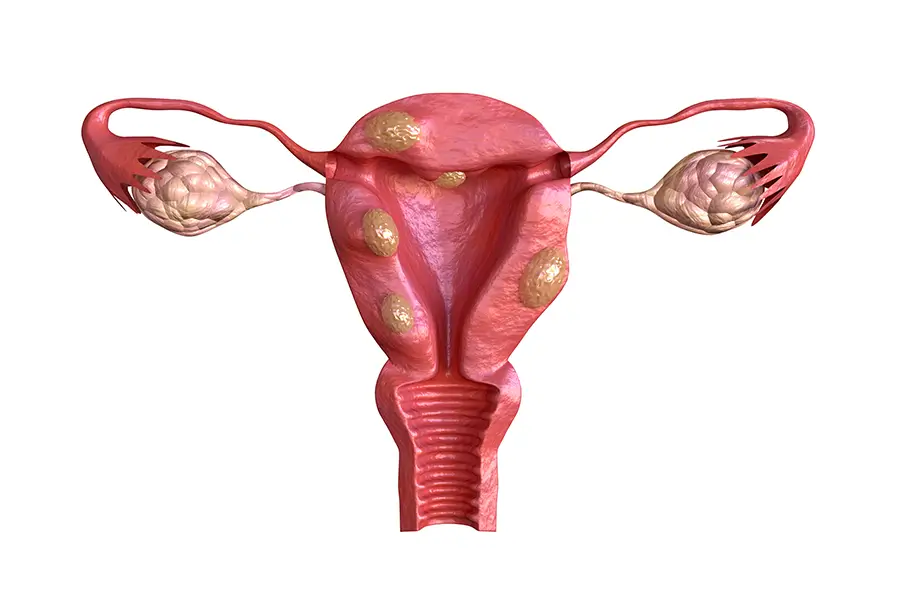What are Fibroids?
Fibroids, also known as uterine leiomyomas, are noncancerous growths that develop in the wall of the uterus. They are the most common type of benign tumor found in the reproductive system of women. Fibroids are composed of smooth muscle cells and fibrous connective tissue. While the exact cause of fibroids is unknown, hormones, particularly estrogen, are believed to play a significant role in their development and growth.

Symptoms of fibroids
Many women with fibroids experience no symptoms at all. However, when symptoms do occur, they can vary depending on the size, location, and number of fibroids present. Some of the most common symptoms include:
- Heavy or prolonged menstrual bleeding
- Pelvic pain or pressure
- Frequent urination or difficulty emptying the bladder
- Pain during intercourse
- Pain in the lower back or legs
- Abdominal bloating or enlargement
- Difficulty getting pregnant
Types of fibroids
Fibroids can be categorized based on their location within the uterus:
- Intramural fibroids: These are the most common type, located within the muscular wall of the uterus.
- Subserosal fibroids: These fibroids grow on the outside of the uterus. They may sometimes become pedunculated, meaning they are attached to the uterus by a stalk.
- Submucosal fibroids: These fibroids project into the uterine cavity.
Risk factors for fibroids
Several factors can increase a woman’s risk of developing fibroids, including:
- Age: Fibroids are most common between the ages of 30 and 50.
- Family history: Having a close relative with fibroids increases your risk.
- Race: African American women are more likely to develop fibroids than women of other races.
- Weight: Obesity is a risk factor for fibroids.
- Early menstruation: Starting your period before the age of 11 may increase your risk.
- Never having been pregnant: Pregnancy seems to have a protective effect against fibroids.
Diagnosing fibroids
If you are experiencing symptoms that suggest fibroids, your doctor will perform a pelvic exam and may order one or more of the following tests:
- Ultrasound: This imaging test can help identify the size, location, and number of fibroids.
- Hysteroscopy: A thin, lighted scope is inserted into the uterus to directly visualize the uterine cavity.
- Sonohysterography: This is a special type of ultrasound that uses saline solution to distend the uterine cavity for better visualization.
- MRI: Magnetic resonance imaging can provide detailed images of the uterus and surrounding tissues.
Treatment options for fibroids
There are various treatment options available for fibroids, depending on the severity of symptoms, the size and location of the fibroids, and your desire for future pregnancy. Some of the most common treatments include:
- Watchful waiting: If your symptoms are mild, your doctor may recommend monitoring the fibroids with regular checkups.
- Medications: Medications such as birth control pills or GnRH (gonadotropin-releasing hormone) agonists can help shrink fibroids by reducing hormone levels.
- Minimally invasive procedures: Uterine fibroid embolization (UFE) is a minimally invasive procedure that blocks the blood supply to the fibroids, causing them to shrink. Myomectomy is a surgical procedure to remove the fibroids while preserving the uterus.
- Hysterectomy: This is the surgical removal of the uterus, which is considered a last resort when other options have failed or pregnancy is no longer desired.
Living with fibroids
For many women, fibroids can be successfully managed with medication or minimally invasive procedures. If you are diagnosed with fibroids, it is important to discuss all treatment options with your doctor to determine the best course of action for your individual needs.
Schedule a Consultation
Fibroids are a common condition, but you don’t have to suffer in silence. If you are experiencing symptoms that suggest fibroids, schedule an appointment with your doctor to discuss your concerns. At Preferred Fibroid, we are committed to providing women with the information and treatment options they need to manage fibroids and improve their quality of life. We offer minimally invasive procedures like Uterine Fibroid Embolization (UFE) that can effectively shrink fibroids with minimal recovery time. Contact Preferred Fibroid today to learn more about UFE and how it can help you take control of your fibroid journey.
